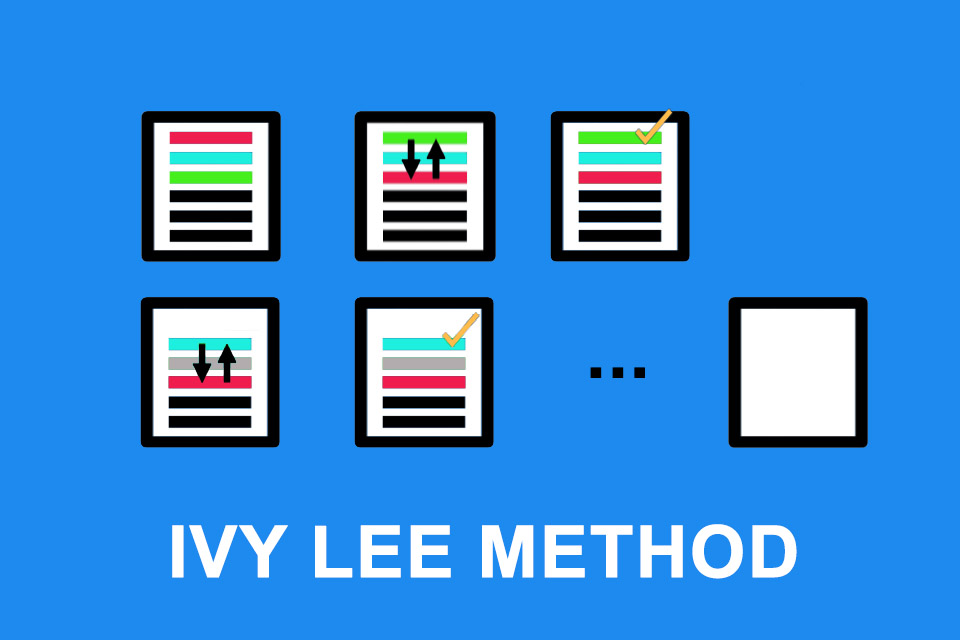What is the Ivy Lee Method?
Smartpedia: The Ivy Lee Method is a time management technique that advocates a short, repeatedly prioritised task list for focused completion.
Ivy Lee Method – prioritising and focusing on tasks
The Ivy Lee Method is a time management technique that uses a prioritised task list to promote the planned, focused completion of tasks. The method is considered particularly simple because it is easy to implement and helps to focus on the most important tasks. In addition, it encourages the prioritisation of tasks to be reviewed regularly and adjusted if necessary, which helps to ensure that important tasks are not overlooked and that current shifts are taken into account.
Challenges in mastering the Ivy Lee Method include sticking to task prioritisation, staying focused, avoiding distractions and not getting distracted by less important tasks. Especially when people are working on several projects, the phone is ringing regularly, new information is constantly landing in the email inbox, this sounds much easier in theory than it is in practice.
25,000 Dollar Method or the Charles Schwab Anecdote
The Ivy Lee Method is sometimes also called the “25,000 dollar method”. This name comes from an anecdote¹ involving Charles M. Schwab², the president of the Bethlehem Steel Corporation in Pennsylvania and one of the richest men in the world at the time. Schwab approached the US communications manager and co-founder of modern public relations Ivy Lee³ in 1918 because he was looking for a way to improve the productivity of his employees. According to the anecdote³, Lee explained his method for 15 minutes and agreed that a select group of employees would use it. Schwab would be free to decide after three months what this method was worth to him in fees. Three months later, he paid an impressive $25,000 as a fee for the time and spoke of the “best and most profitable lesson of his life”.
The Ivy Lee Method Procedure
The procedure of the Ivy Lee Method is relatively simple:
- At the end of each working day, take enough time to record essential tasks for the next working day in a list.
- Prioritise the most important 6 tasks. These are to be worked through one after the other the next day.
- Start without delay on the next working day with the first and therefore most important task.
- Once you have completed this task, take a short break, check the priorities of the other tasks, adjust them if necessary and take the most important break again.
- Repeat this process until all tasks have been completed.
- At the end of the working day, make a new list of essential tasks for the coming working day.
Sounds simple, doesn’t it?
Claim and reality of the Ivy Lee Method
The Ivy Lee Method saw the light of day in 1918. At that time, however, this world functioned differently than our working world does today. Presumably, the demand to work as productively as possible has also increased over the last 100 years. What has certainly changed, however, is the level of distraction today. People constantly receive emails with requests, wishes, ideas, problems. The phone rings non-stop. Colleagues are looking for a sympathetic ear and/or professional support. Meeting follows meeting, video conference follows video conference, chat follows chat. Today’s working life is characterised by fast pace, responsiveness, pressure to turn over money. Deadlines, interdisciplinary teams and an infinite number of tools…
The Ivy Lee Method is – simply put – nothing more than a prioritised to-do list. And with that comes some questions in practice:
- How is the prioritisation done? Possibly by importance or by urgency, as recommended by the Eisenhower Matrix?
- How much time of the day should be planned and how much time can actually be planned?
- How much buffer should be considered when planning individual tasks?
- How extensive should/could individual tasks be?
- What happens to tasks that can be delegated? (Here it is worth taking a look at Delegation Poker!)
- What happens to tasks that are worked on in collaboration with colleagues?
- What roles do stages of completion play?
- How can distractions and disruptions be avoided?
- What happens to planning when new urgent or important tasks come up early in the morning?
- Should unfinished tasks automatically end up on the following day’s schedule?
The list of questions can be extended indefinitely. On the one hand, this means that the Ivy Lee Method, in its simplicity, does not cover all topics and fit all situations. On the other hand, it helps to increase personal productivity by focusing on concentrated work on important tasks. And this personal focus on individual activities is also an important success factor in today’s working world.
Tips for working with the Ivy Lee Method
There are some tips when using the Ivy Lee Method:
- Define for yourself how many tasks you put on your daily list. Whether it is 6, 7 or 8 is secondary. The approach provides you with a structure that should make your working day easier.
- Do not schedule your entire working day – that is bound to fail practically. There are too many imponderables and distractions for that. Find out for yourself whether it makes sense, for example, to schedule “only” half of the working day. This will give you a buffer for other activities and possibly also a little less pressure.
- Think about which tools are helpful for your time planning. Maybe an approach like the Pomodoro Technique, which alternates 25-minute work intervals with 5-minute breaks, would help?
And last but not least, talk to your colleagues about how they plan their tasks. What works well for them, what challenges do they have to overcome, what experiences have they gained? The answers will ideally help to improve your productivity a little bit. Charles M. Schwab would certainly
Impulse to discuss
Do you plan and structure your working day differently from your colleagues?
[1] Ivy Lee was known to be an expert in communication. It can therefore be assumed that the story may not have taken place entirely as described. As an anecdote, however, it impressively showcases the importance and value of effective work and thus probably achieves its purpose.
[2] Charles M. Schwab
[3] Ivy Lee
Here you can find a German-language video that explains the Ivy Lee Method schematically.
If you like the article or would like to discuss it, please feel free to share it in your network. And if you have any comments, please do not hesitate to send us a message.
Here you will find additional information from the t2informatik Blog:



